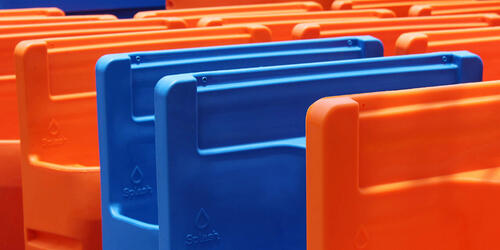 BACK TO HOMEPAGE >
BACK TO HOMEPAGE >

Splash Drinking and Handwashing Stations 2017-2019
Designers: Nick Ellington, Eric Stowe, Megan Williams, Mike Kollins, Splash, and Leslie Llado, Splash, Seattle, Washington, USA and Markus Wierzoch and Dustin Horn, Artefact, Seattle, Washington, USA
Manufacturer: Splash, Seattle, Washington, USA
Behavior change research and smart, scalable industrial design unite in these unique drinking and handwashing stations designed to encourage healthy hygiene habits in children living in urban poverty.
Splash identified a need for improved handwashing and drinking water stations in the countries where they worked in Africa and Asia, but were unable to locate high-quality products. The stations available in the market were time-consuming to construct and maintain, and made from low-quality materials that broke with repeated use. Additionally, stations were designed for adults, rather than children, with tall basins and sharp edges and corners.
Innovation design firm Artefact and international development organization Splash combined research insights with craft and functionality to design unique drinking and handwashing stations that are both engaging for children and accessible to local communities. Their inventive yet simple form also allows for local manufacturing and easy installation and maintenance.
Community is at the heart of the stations’ design. The innovative new drinking and handwashing stations are designed for use in schools and other child-serving, institutional settings for the widest impact in educating and inspiring healthy habits. The result is a behavioral research-driven, culturally conscious, highly scalable design with several innovative features.
Research-driven design. Artefact and Splash developed a novel triangular design that allows children to see and interact with each other when handwashing, while remaining suitable for local wall plumbing. The design is informed by research from UNICEF suggesting that children who see each other wash their hands are more likely to adopt and sustain the habit.
Visual signals. Bright colors and functional icons differentiate safe drinking water stations from handwashing stations, promoting separation of drinking and handwashing behaviors and reducing the potential for disease transmission. Additionally, the drinking water station has a deeper sink to allow for a one-liter bottle to be easily filled, while the handwashing station has a shallow basin to discourage drinking. Handwashing stations have conspicuous soap trays that prompt children to use soap or replace it if it is missing.
Culturally conscious. The drinking stations have water fountains on the right-hand side to respect cultures that require eating and drinking with the right hand.
Community-friendly. With pre-installed plumbing and a smooth exterior, the stations are simple by design so that schools and institutions can easily install and maintain them. There is no need for specialized labor or tools.
- Local context. The use of rotationally molded plastic makes for more consistent and cost-effective manufacturing that can occur in the countries where Splash works. This helps facilitate technology transfer and wide-scale adoption.
Launched in 2019, more than 2,000 schools and one million kids in India and Ethiopia will adopt the stations over the next five years, with the goal of reaching other community organizations and governments as well. The stations will help consistently reinforce good hygiene habits and improve well-being throughout the community for both children and adults.


